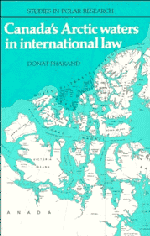Book contents
- Frontmatter
- Contents
- Figures
- Tables
- Foreword
- Preface
- Acknowledgements
- Part 1 The Waters of the Canadian Arctic Archipelago and the Sector Theory
- Part 2 The Waters of the Canadian Arctic Archipelago as Historic Waters
- Part 3 The Waters of the Canadian Arctic Archipelago and Straight Baselines
- 9 The law on straight baselines for coastal Archipelagos
- 10 State practice on the use of straight baselines
- 11 Straight baselines applied to the Canadian Arctic Archipelago
- Notes
- Part 4 The Waters of the Canadian Arctic Archipelago and the Northwest Passage
- Notes
- General Conclusion
- Appendix A The 1825 Boundary Treaty, Great Britain and Russia
- Appendix B The 1867 Boundary Treaty, United States and Russia
- Selected bibliography
- Index
11 - Straight baselines applied to the Canadian Arctic Archipelago
Published online by Cambridge University Press: 20 January 2010
- Frontmatter
- Contents
- Figures
- Tables
- Foreword
- Preface
- Acknowledgements
- Part 1 The Waters of the Canadian Arctic Archipelago and the Sector Theory
- Part 2 The Waters of the Canadian Arctic Archipelago as Historic Waters
- Part 3 The Waters of the Canadian Arctic Archipelago and Straight Baselines
- 9 The law on straight baselines for coastal Archipelagos
- 10 State practice on the use of straight baselines
- 11 Straight baselines applied to the Canadian Arctic Archipelago
- Notes
- Part 4 The Waters of the Canadian Arctic Archipelago and the Northwest Passage
- Notes
- General Conclusion
- Appendix A The 1825 Boundary Treaty, Great Britain and Russia
- Appendix B The 1867 Boundary Treaty, United States and Russia
- Selected bibliography
- Index
Summary
The possibility of enclosing the Canadian Arctic Archipelago with straight baselines has been discussed by a number of writers since the Fisheries Case of 1951, particularly after the Manhattan crossing of the Northwest Passage in 1969. Their writings have already been reviewed by the present writer and suffice it to recall here that, subject to a few nuances, they all arrived at the conclusion that those waters could be enclosed in a way similar to those of the Norwegian Archipelago. In spite of the virtual unanimity in the conclusion, the reasons varied somewhat from one writer to another, particularly as to the precise legal nature of the Canadian Archipelago, the use which could be made of history and the consequence which straight baselines would have on any right of passage that might now exist. In light of the applicable law and the practice of States already discussed, this chapter will examine: (1) the geography of the Canadian Arctic Archipelago; (2) straight baselines for the Archipelago; and (3) the consolidation of title to certain waters enclosed by straight baselines.
The geography of the Canadian Arctic Archipelago
In the Fisheries Case of 1951, the International Court concluded that ‘the method of straight baselines, established in the Norwegian system, was imposed by the peculiar geography of the Norwegian coast’. The question arises here whether the geography of the northern coast of Canada is of a similarly peculiar nature so as to warrant the method of straight baselines for the delimitation of its territorial waters.
- Type
- Chapter
- Information
- Canada's Arctic Waters in International Law , pp. 159 - 179Publisher: Cambridge University PressPrint publication year: 1988



